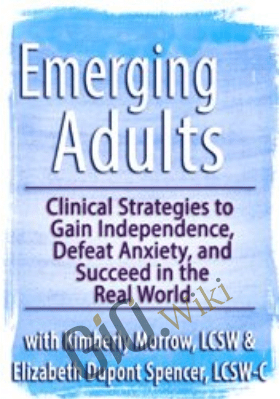$149.00 Original price was: $149.00.$44.00Current price is: $44.00.
Digital Download: You will receive a download link via your order email
Save up to 85% compared to Salepage prices. In addition, earn additional points. Save more on your next order.
Please contact email: [email protected] if you have any questions about this course.
 Purchase this course you will earn 44 Points worth of $4.40
Purchase this course you will earn 44 Points worth of $4.40 Karen Pryor & Varleisha D. Gibbs – Certificate Course to Integrate Primitive Reflexes for Optimal Function
Karen Pryor & Varleisha D. Gibbs – Certificate Course to Integrate Primitive Reflexes for Optimal Function
The presence of retained primitive reflexes can exacerbate hyperactivity, inattentiveness, and challenges with processing sensory stimuli.
And the simplest techniques can have the most profound effects on patient progress.
These seemingly small changes can be a catalyst for increase in developmental success to your patients with neurological deficits, behavioral challenges, autism, sensory processing problems, learning disabilities, and ADHD…
Now, for the first time ever! You will learn through the lens of a physical therapist, Karen Pryor, PhD, PT, DPT, ND, CH, CFPS, and an occupational therapist, Varleisha Gibbs, PhD, OTD, OTR/L…
…as they guide you through the missing links you need to achieve the results you desire and the patient satisfaction you know they deserve with the help of neuroplasticity techniques.
In this innovative online course, Karen Pryor, PhD, PT, DPT, ND, CH, CFPS, and Varleisha Gibbs, PhD, OTD, OTR/L, will provide you guidance to re-envision treatment planning and strategies. Plus…
- Be led through case studies on what happens when trauma exposes primitive reflex dominance and influences overall function.
- Learn step-by-step how primitive reflexes highlight the impact on developmental skills, learning, and behavior from function to dysfunction.
- Review the central nervous system anatomy and physiology as it relates to reflexive motor patterns, which includes the cranial nerves, and the various levels of the central nervous system.
Join your peers today and discover how to integrate primitive reflexes and reduce their influences on higher level skills.
You’ll leave with treatment strategies including case examples, useful handouts, and activities to address handwriting, dressing, eating, and positioning.
Here’s what you’ll get:
Module 1
Join Karen Pryor, PhD, PT, DPT, ND, CH, CFPS, and Varleisha Gibbs, PhD, OTD, OTR/L, as they come together to review the primitive reflexes and highlight each impact on developmental skills, learning, and behavior from function to dysfunction.
Review the central nervous system anatomy and physiology as it relates to reflexive motor patterns, which includes the cranial nerves, and the various levels of the central nervous system.
Learn to integrate primitive reflexes and reduce their influences on higher level skills.
Neurological Overview
- Primitive Reflex – Need to know
- From “infancy to classroom”
- Tone qualities and influencers
Nervous System Anatomy and Brain Loops – Sensory In, Motor Out
- Reticular activating system – how underlying wiring of CNS interprets sensory information coming in and motor output
- Brainstem
- Midbrain
- Cortex
From Function to Dysfunction of Primitive Reflexes
- Causes of retention and obligatory reflex demonstration
- Triggers
Primitive Reflex Treatment Strategies
- Activities to address function
- Treatments
- Conclusion
Understanding primitive reflexes and how they live in the lower brain centers gives us control in the integration process.
Nervous system damage or challenges require neuroplasticity tools for effective treatment.
In this one-hour case study Karen Pryor, PhD, PT, DPT, ND, CH, CFPS, gives you a new perspective on how to enter the central nervous system with sensory information to assist in rewiring around impairments for improved motor outcomes.
Evaluation – Look at the patient functionally to see the nervous system
- Purpose for primitive reflexes
Causes for primitive reflex obligatory demonstration
- How the brain relates information for survival
Case study
- History
- Evaluation
Treatment – Cranial nerve sensory pathways used for rewiring
- Use of lobes for neuroplasticity advancement
- How to naturally decrease spasticity effectively
- Progress of the patient
- Results
Primitive reflexes are the developmental groundwork for independence.
When they do not properly integrate, primitive reflexes can overpower executive functioning, sensory processing, and emotional regulation.
In this one-hour case study, Varleisha Gibbs, PhD, OTD, OTR/L, provides treatment strategies to improve participation and function in children and adolescents.
Case examples
- Activation of primitive reflexes
How primitive reflexes connect to Self-Regulation
- Neurological pathways for executive function, sensory processing, and emotional regulation
Case study
- History
- Evaluation
Treatment
- The 9 Targets
- Contextual Sensory Intervention
- Results
- Recap of key takeaways from the course
- Review of hot topics, additional insight, guidance, and answers to questions by Karen Pryor, PhD, PT, DPT, ND, CH, CFPS, and Varleisha Gibbs PhD, OTD, OTR/L
Improve treatment for your clients by discovering the link between primitive reflexes and development.
Learn to evaluate the influence of primitive reflexes with central nervous system developmental stages, as it relates to function.
Practice simple techniques to immediately add to your treatment sessions, leading to increased developmental success: Behavioral Challenges, Learning Disabilities, Neurological Deficits, Sensory Processing Problems, Autism and ADHD.
Meet Your Course Experts:

Karen Pryor, PhD, PT, DPT, ND, CH, CFPS, has a doctorate in physical therapy and has practiced for over 40 years in the field. Dr. Pryor is the owner of Health Sphere Wellness Center, an integrative therapy clinic in Tennessee. Involved with early intervention in the birth-three population for over 30 years, she has developed neuroplasticity techniques that are used in a wide variety of settings, including homes, childcare centers, and school systems, to advance pediatric therapy programs. She is the author of Ten Fingers Ten Toes Twenty Things Everyone Needs to Know.
Dr. Pryor serves on several boards, including the Leadership Interagency Council for Early Intervention, (2014-2024), a position to which she was appointed by Tennessee Governor Bill Haslam and Governor Bill Lee. In 2010, she received the President’s Volunteer Service Award for her contributions to the advanced treatment of children from President Barack Obama. In addition to her work with children, Dr. Pryor has served as an adjunct professor at the Tennessee State University Occupational Therapy School, and in the Volunteer State Community College Physical Therapy Assistant program. She is a clinical instructor for several universities and colleges. With her years of experience and passion for complete wellness, Dr. Pryor advances a more expansive view of how to integrate therapy throughout the lifespan by using COMPASS neuroplasticity techniques.

Varleisha D. Gibbs, PhD, OTD, OTR/L, is an occupational therapist and author with 17 years of experience working with children and adolescents diagnosed with Autism Spectrum Disorder, Sensory Processing disorders and Neurological disorders. Dr. Gibbs is the Scientific Programs Officer for the American Occupational Therapy Foundation. She is the inaugural chair and director of the master’s programs in occupational therapy and full-time associate professor at Wesley College in Dover, DE. Prior to joining Wesley, she worked at the University of the Sciences in Philadelphia, PA, where she served as the director of the doctoral programs in occupational therapy.
Dr. Gibbs is steadfast and an expert in the field of neurology, cognition, and pediatric therapeutic intervention. She continues to lecture, and provide training, on sensory processing strategies and self-regulation to practitioners, parents, and teachers throughout the country and internationally. Dr. Gibbs is the developer of the Self-Regulation and Mindfulness program, and her new book, Self-Regulation and Mindfulness: Exercises and Worksheets for Sensory Processing Disorder, ADHD, and Autism Spectrum Disorder, was published in 2017 (PESI Publishing & Media). As co-author of Raising Kids with Sensory Processing Disorders, she has provided families with strategies to understand and care for their children.
In 2003, Dr. Gibbs founded Universal Progressive Therapy, Inc., a company that provides interdisciplinary and quality therapeutic services to families. As founding president, she provided treatment interventions and education in the areas of sensory integration, autism as well as family-centered care. Dr. Gibbs co-authored the publication, “Family-Centered Occupational Therapy and Telerehabilitation for Children with Autism Spectrum Disorders”, found in the journal of Occupational Therapy in Healthcare. She received her PhD at Seton Hall University with a dissertation focusing on the Autism Spectrum diagnosis. Dr. Gibbs earned her doctorate in occupational therapy at Thomas Jefferson University and her master’s training in occupational therapy from Columbia University.
Salepage: https://catalog.pesi.com/sales/rh_c_001413_integrateprimitivereflexes_organic-156117
Archive: https://archive.fo/wip/Gfc5j
Delivery Method
Be the first to review “Karen Pryor & Varleisha D. Gibbs – Certificate Course to Integrate Primitive Reflexes for Optimal Function” Cancel reply
Related products
Health and Medical
= 18 Points
Health and Medical
= 33 Points
Health and Medical
MyBeliefworks for Pain Relief, Chronic, Pre Op/Post Op to Pain-free Recovery – Jimmy Mack
= 25 Points
Health and Medical
= 53 Points
Health and Medical
= 72 Points
Health and Medical
Certificate Course in Optimal Aging: Evidence-Based Interventions for Older Adults – Carole Lewis
= 95 Points
Health and Medical
= 27 Points
Health and Medical
= 34 Points











Reviews
There are no reviews yet.